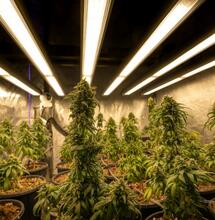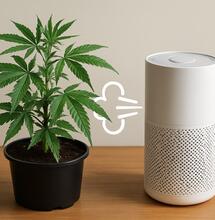A Beginner's Guide - The Best Pots and Growing Medium for Cannabis Plants

As a first-time grower, knowing which pots and medium will work best can be challenging. With so much choice, knowing the best option for you and your growing space can be tricky. In this article, I summarise all you need to know about the various solutions and highlight the pros and cons.
The Different Types of Pots for Cannabis Plants
If you have ever visited your local grow store, you may have been overwhelmed by all the different pots and growing mediums. Cannabis plants require a pot to grow inside and a medium that provides plenty of nutrients for the plant's life cycle. Below is a breakdown of the different types of pots.
Plastic Pots for Cannabis Plants
The Pros of Plastic Pots:
Plastic round pots are cheap and easy to find at a local garden centre. They can be washed and used again after each harvest. Small pots are inexpensive and a great way to start your grow without spending much money.
Labelling plastic pots with sticker labels is simple and will not fall off, regardless of heat. Royal Queen Seeds recommends that if you grow your plants in soil, they'll be situated on the floor and fit comfortably, as square pots help maximise space per m².
The Cons of Plastic Pots:
When used for outdoor grows, plastic pots exposed to sunlight can become brittle and start to split after multiple uses. Roots can also become root-bound quite quickly if you do not transplant your cannabis plant into a larger pot to provide more room for the roots to expand. Nutrient salts can build up inside plastic pots and be almost impossible to wash off.
Air Pots for Cannabis Plants
The Pros of Air Pots:
Because of the uniform holes in the side of the air pots, roots grow and prune themselves when exposed to air. This creates a prolific root network that produces many cannabis roots when examined at the end of harvest.
This is the exact reason why cannabis plants can produce impressive yields when an air pot is used. Air pots are available in multiple sizes, can be used with all growing mediums, and can be washed and reused after every harvest.
The Cons of Air Pots:
Air pots are the most expensive type available, and even though they are well worth the investment, they may be out of a beginner grower's budget. Watering air pots can cause the water to pour out of the sides, resulting in potential overwatering or underwatering. Bottom feeding with air pots using a saucer is not as straightforward as using a plastic pot and saucer.
Fabric Round Pots for Cannabis Plants
The Pros of Fabric Round Pots:
Fabric pots are my favourite pots for growing cannabis. They are most often made from thick felt and can be lifted easily. In the same way, the roots of air pots encourage root pruning, and the roots of fabric pots do the same, resulting in a well-developed root zone. You can sew together felt and create custom-sized fabric pots, which I have done for many years.
The Cons of Fabric Round Pots:
You won't be able to transplant the same way you would with a plastic round or square pot, as the roots will have grown into the fabric. So this means you need to place the fabric pot inside a larger one if you plan to repot them, which can be slightly unresourceful and may require 2-3 fabric pots for one large-sized plant.
The Best Growing Medium for Cannabis
Now that you know the pots that can be used for growing cannabis plants, the next thing to understand is which growing medium is best. Not all growing mediums have the same properties, and some are used for organic growers, while others are used for hydroponics. Below is an explanation of how each differs and what you need to know before filling your chosen pots.
Soil for Cannabis Plants
The Pros of Soil:
Soil can be found in all garden centres or grow shops; some are cheap, and others may be expensive. Soil provides slow-release nutrients that cannabis plants require during the seedling, vegetation, and flowering stages. Thanks to the 72-hour buffering zone associated with soil, beginner growers do not need to worry about overfeeding their plants, especially when using plain water.
The Cons of Soil:
Not all soil for growing cannabis has the right amount of aeration, drainage ability, or water-retaining properties. As Auto-Seeds advises, if the soil does not drain well, it tends to become dense and heavy, which can severely restrict root growth and overall plant development.
Also, many commercially available soils contain a high amount of fertilisers, which can cause seedlings and clones to burn. My tip is to look at the label of any soil you buy and avoid anything with an N-P-K ratio of 20-20-20, as this will indicate that it has chemicals inside.
Compost for Cannabis Plants
The Pros of Compost:
Compost is a very easy-to-work-with, slow-release organic nutrient rich in beneficial bacteria and fungi. Good-quality compost also contains high amounts of magnesium, which is optimal for magnesium-hungry plants such as O.G. Kush. Compost is relatively cheap to buy and easy to source, and when mixed with soil or coco coir, it provides a soft and airy growing medium that roots love.
The Cons of Compost:
Not all compost you buy will be fresh, especially bags sitting inside a warehouse or garden centre for long periods. Beware also that growing from seed to harvest using only compost as a medium may not produce the most significant yields, and you may need to supplement the compost with liquid nutrients to avoid nutrient deficiencies.
Peat Moss for Cannabis Plants
The Pros of Peat Moss:
When it comes to water retention, peat moss is the best option, thanks to its ability to hold a high volume of water. Peat moss is also sterilised and can help control pathogens in the soil. Compared to soil, peat moss is a lightweight substrate and, when mixed with other mediums, can help keep moisture levels in the pot moist for days without saturating. Hydroponic growers will use peat and perlite together as an inert growing medium.
The Cons of Peat Moss:
Peat moss is mined from peat bogs and is a natural resource that cannot be replaced. This means that from an eco-friendly perspective, it is not renewable. Peat moss also tends to dry out very fast. It does not contain any nutrients, so it needs to be mixed with soil or compost to be an effective growing medium for cannabis plants. The pH of peat moss ranges between 3.0 and 4.5, so it is far too acidic for cannabis by itself.
Coco Coir for Cannabis Plants
The Pros of Coco Coir:
Coco coir contains high amounts of air, which roots thrive in, resulting in a healthy and compact root zone. Cloning cannabis plants in coco coir often results in a quicker turnaround time compared to soil, which is why coco coir pellets are extremely popular. When mixed with soil or compost, coco coir can produce the ultimate growing medium, making it versatile and usable for organic or soilless applications.
The Cons Coco Coir:
Coco Coir is naturally rich in potassium but poor in calcium, so according to Atami, if you don't balance that from the start, your plants will show deficiencies fast. Top-quality coco coir is not cheap compared to some commercially available soil and is only sold in grow shops. Beware of compressed dry coco coir blocks, as they most often contain high amounts of salt, resulting in a high EC level for seedlings.
My Conclusion
You can always mix the different growing mediums to create a custom mix that ticks all the boxes regarding drainage, wicking ability, and air pockets. I recommend adding perlite, hydroton, or vermiculite if making a custom growing mix. Experiment with different growing mediums and see which one works best for you. Always check the label to check the nutrient ratio before buying, and avoid over-fertilised soils!



